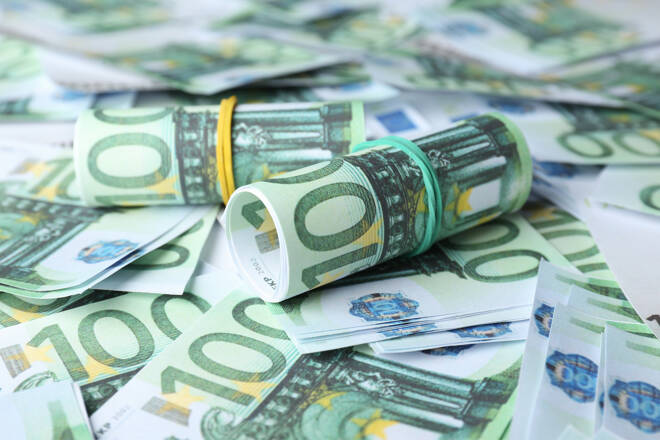Advertisement
Advertisement
EUR/USD Weekly Forecast: Six Weeks in Red — Is the ECB Rate Hike on Shaky Ground?
By:
EUR/USD forecast remains uncertain as hawkish Fed remarks, German economy woes, and US nonfarm payrolls dictate the currency's trajectory.
Highlights:
- The EUR/USD suffers six weekly losses, influenced by hawkish Fed remarks and declining private sector PMIs.
- Rising unemployment and falling retail sales in Germany could ease demand-driven inflation pressures.
- The US Jobs Report needs to show wage growth and steady unemployment to fuel September rate hike bets.
Overview
The EUR/USD extended the losing streak to six weekly losses. In the week ending August 25, the EUR/USD declined by 0.68%. Following a 0.70% fall from the previous week, the EUR/USD closed at $1.07946. Private sector PMIs and a hawkish Fed Chair Powell speech left the EUR/USD on the back foot.
Significantly, the EUR/USD struck a Tuesday high of $1.09304 before sliding to a Friday low of $1.07658.
Inflation and the German Economy in the Spotlight
The German economy will be in the spotlight again. After the grim flash private sector PMI numbers last week, consumer sentiment, consumer spending, and labor market numbers will influence.
German inflation figures could raise bets on a September ECB rate hike. However, weaker consumer confidence, a rise in unemployment, and a fall in retail sales could test hawkish bets.
Falling consumer confidence, retail sales, and an upward trend in unemployment should ease demand-driven inflation. Concerns over the Eurozone economy and easing demand-driven inflationary pressures should reduce bets on an ECB interest rate hike.
However, Eurozone inflation numbers would need to support an ECB hold. A pickup in the core annual inflation rate would reignite bets on an ECB move.
On Friday, manufacturing PMI numbers for Italy and Spain and finalized numbers for France, Germany, and the Eurozone will also influence sentiment. Revisions to flash PMI for the Eurozone and numbers from Italy will have more impact.
With inflation and the German economy in focus, the ECB monetary policy meeting minutes also need consideration on Thursday. The minutes will give investors clues on how ECB Executive Board members will consider the latest round of economic indicators.
ECB Executive Board members Isabel Schnabel (Thurs) and Luis de Guindos (Thurs) are on the calendar to speak this week.
US Nonfarm Payrolls to Have the Final Say
After the hawkish Fed Chair Powell speech on Friday, the week ahead could cement a September Fed rate hike.
JOLTs job openings and consumer confidence numbers will draw interest on Tuesday. A pickup in consumer confidence and steady job openings would be bullish for the dollar.
However, ADP nonfarm employment change and Q2 GDP numbers would need to support the more hawkish outlook. A weak ADP number and downward revisions to GDP numbers could test hawkish sentiment.
On Thursday, the core PCE price index, personal spending, and jobless claims will have more impact. Sticky inflation, an upward trend in consumption, and tight labor market conditions would pressure the Fed to push rates higher.
However, the US Jobs Report should reflect a pickup in wage growth and a steady unemployment rate to fuel bets on a September move.
EUR/USD Technical Indicators
Daily Chart
The Daily Chart showed the EUR/USD below the $1.0900 – $1.0850 resistance band. After the weekly loss, the EUR/USD sat below the 50-day EMA and the 200-day EMA, sending bearish near and longer-term price signals.
Looking at the 14-Daily RSI, the 32.82 reflects a bearish sentiment. The RSI and EMAs signal a fall through the $1.0750 – $1.0700 support band to bring sub-$1.07 into play.
However, a EUR/USD move through the 200-day EMA would give the bulls a run at the $1.0850 – $1.0900 resistance band and the 50-day EMA.
4-Hourly Chart
Considering the 4-Hourly Chart, the EUR/USD sits above the $1.0750 – $1.0700 support band. However, the EUR/USD remains below the 50-day and 200-day EMAs, affirming bearish near and longer-term price signals.
The 14-4H RSI at 37.96 reflects a bearish sentiment, with selling pressure outweighing buying pressure. Significantly, the RSI and the EMAs signal a fall through the $1.0750 – $1.0700 support band to bring sub-$1.07 into play. However, a move through the lower level of the $1.0850 – $1.0900 resistance band would give the bulls a run at the 50-day EMA.
Price action will likely hinge on the US Core PCE Price Index and US Jobs Report.
About the Author
Bob Masonauthor
With over 28 years of experience in the financial industry, Bob has worked with various global rating agencies and multinational banks. Currently he is covering currencies, commodities, alternative asset classes and global equities, focusing mostly on European and Asian markets.
Advertisement
